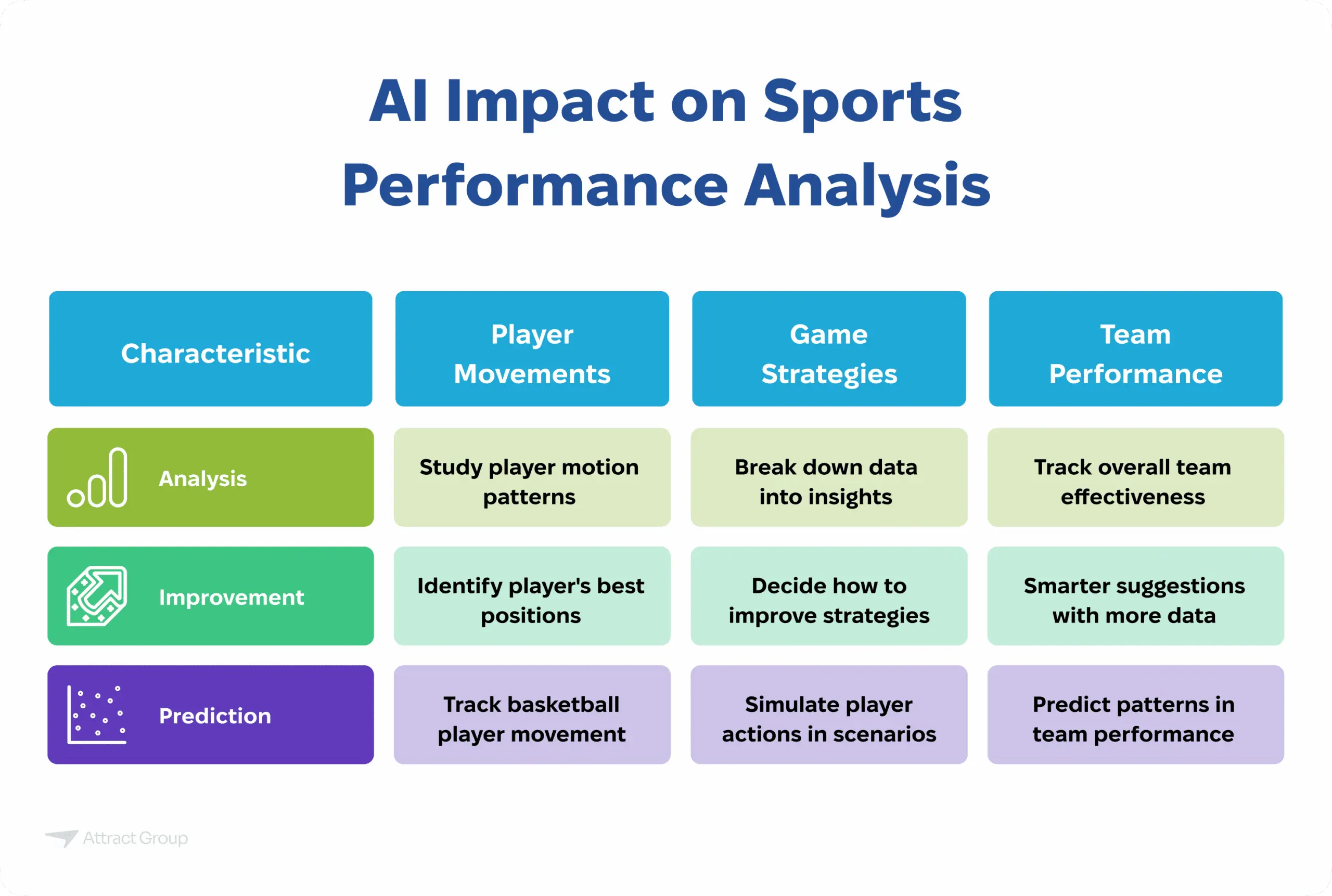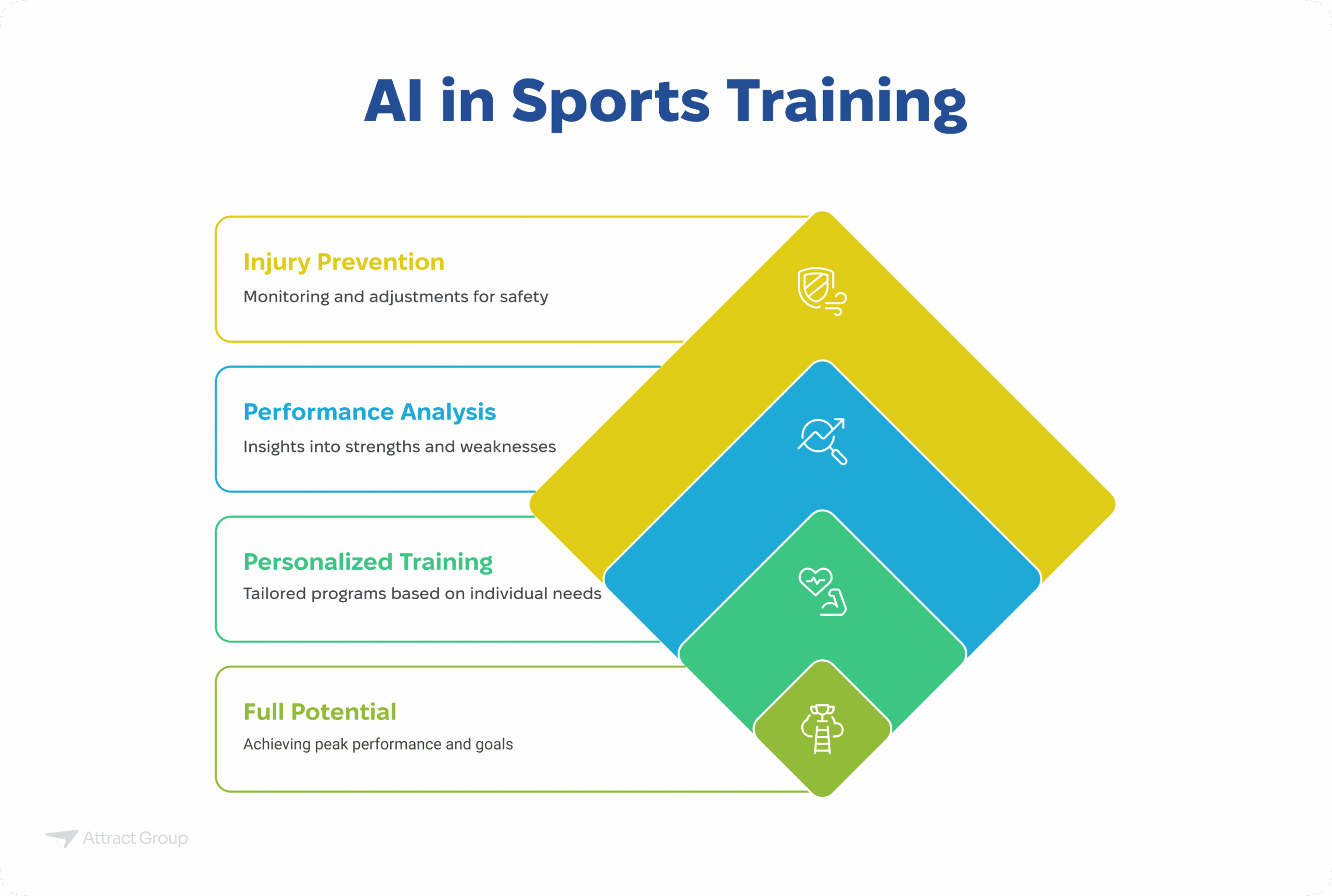How Artificial Intelligence is Revolutionizing Professional Sports | AI in Sports
 26 December 2024
26 December 2024Artificial Intelligence (AI) is transforming the landscape of professional sports, reshaping how athletes train, teams strategize, and fans engage with the game. From optimizing player performance to revolutionizing broadcasting and officiating, AI is driving innovation across the sports industry.

In this article, you’ll discover 10 groundbreaking ways AI is revolutionizing sports, showcasing its impact on athletes, coaches, and fans alike. Dive in to explore the future of sports powered by AI.
1. Performance Analysis
AI has completely changed how you analyze performance in sports. When you use AI, it helps you study player movements, game strategies, and overall team performance. For example, you can track how a basketball player moves on the court to find out where they perform best.
AI-powered analytics tools break down massive amounts of data into simple, clear insights. These insights can help you decide how to improve. With machine learning, you can predict patterns in how teams or players perform over time. This means you get smarter suggestions the more data you have.
Some tools even use generative AI to create realistic game scenarios. You can simulate how players might act in different situations. This helps you practice smarter and plan better strategies. Whether it’s soccer, basketball, or cricket, AI gives you a way to focus on details you might miss otherwise.
2. Injury Prevention
The use of AI has made injury prevention smarter and more effective. AI tracks your physical data, like heart rate, muscle strain, and joint movement, while you train or play. It helps you identify signs of fatigue or overuse before they lead to serious injuries. For example, wearable devices powered by tech monitor how your body responds during intense workouts.
AI systems analyze this data in real time to find patterns that may increase your risk of injury. If you are overworking a muscle group or putting too much pressure on a joint, it alerts you so you can adjust your training immediately. This means you can avoid pushing your body beyond safe limits.
If you’re part of sports teams, it helps coaches and medical staff track everyone’s fitness levels. They can use the insights to design personalized training schedules. For instance, some systems recommend rest days or lighter sessions for players who show signs of strain. This ensures everyone on the team stays in peak condition.
With AI use, you also get smarter recovery plans after training or games. It suggests exercises, stretches, or therapies that target specific areas of stress in your body. This personalized care helps you recover faster and stay healthy. By keeping an eye on your body at all times, it acts as a safeguard for your health.
3. Personalized Training
AI has completely changed how you can train for sports. It creates training programs that fit your unique needs and goals. With an such a tool, you can track your strengths, weaknesses, and progress in real time. It looks at data from your past games, training sessions, and even wearable devices. Based on this data, it designs workouts that target your specific needs. For example, if you need to improve your agility, it suggests exercises to build that skill.
Using sports analytics, it breaks down your performance into detailed insights. It shows you what you’re doing right and what you need to work on. For example, if you’re good at sprinting but struggle with endurance, it tailors your training to build stamina. These insights help you focus your energy where it matters most.
It doesn’t just help you improve—it also keeps you safe. By monitoring your physical data, it identifies your injury risk. If it notices that your muscles are being overused or your recovery time is too short, it adjusts your training to prevent injuries. This way, you can stay consistent without putting too much stress on your body.
Trainers and coaches rely on AI in the sports industry to make smarter decisions. They use it to create personalized plans for every player on the team. AI ensures that your training sessions are effective, safe, and designed to help you reach your full potential. It’s like having a personal coach that knows exactly what you need at every step.

4. Talent Scouting
AI is transforming the sports world by making talent scouting smarter and more efficient. With such technology, you can analyze a player’s performance in detail, even during practice or games. It tracks movements, speed, accuracy, and decision-making to find hidden potential.
When you watch sporting events, AI tools can automatically identify standout players. It uses real-time data to highlight skills that are hard to notice with the human eye. For example, it can analyze how quickly a soccer player reacts to changes on the field.
With data analytics, you get insights that go beyond basic stats. It looks at patterns, consistency, and potential for improvement. If a player shows promise, it highlights them as a candidate for your team.
AI can also help you scout players from around the world. It collects data from video footage, online profiles, and performance metrics. This makes it easier to discover new talent without being physically present. By combining AI insights with your expertise, you can make better scouting decisions and build stronger teams.
5. Game Strategy Optimization
Technology is helping you create smarter strategies of game by analyzing every detail of a match. It studies player movements, opponent tactics, and game patterns to find ways to improve your performance. With these tools, you can make better decisions during crucial moments.
Many sports organizations now rely on advanced systems to plan their strategies. These tools predict how opponents might act based on their past games. For example, you can study an opponent’s defensive style and adjust your offensive plays to counter it.
This innovation is also changing sports journalism by providing detailed insights into strategies of game. Analysts can use data to explain why certain plays worked or failed. This makes game analysis more engaging and accurate.
The future of AI in strategy building promises even more advanced tools. Soon, you could simulate full games to test strategies before implementing them. This helps you refine your plans and stay ahead of the competition.
6. Fan Engagement
Technology is changing how you connect with your favorite teams and players. With ai algorithms, you can get personalized updates, game highlights, and player stats delivered right to your devices. This makes following your favorite sports more exciting and engaging.
Teams now leverage AI to create interactive experiences for you. For example, virtual assistants answer your questions about game schedules or team history in real time. You can even participate in live polls or trivia during games to feel more involved.
The use of predictive analytics helps teams suggest content you’ll love. It analyzes your interests to recommend games, videos, or merchandise. This creates a sports experience tailored to what you enjoy most.
AI is making live games more thrilling. You get real-time stats, heat maps, and replays that enhance your understanding of the action. By transforming the sports industry, these tools make sure you feel closer to the game than ever before.
7. Officiating and Rule Enforcement
Technology is changing the way sports officials make decisions during games. Smart systems analyze plays in real time to help referees make accurate calls. For example, in soccer, these tools detect offside positions instantly.
The power of AI helps you avoid errors that can impact the outcome of a match. These systems track player movements and ball positions with high precision. This ensures fairness and consistency in rule enforcement.
The use of artificial intelligence in sports goes beyond games. It also assists in reviewing footage during training sessions. This helps you and your team practice better and avoid penalties during real matches.
In the sports business, these advancements create trust among fans by improving the quality of officiating. Tools like semi-automated decision systems make sure the game remains fair and transparent.
Smart systems even assist in creating a better training plan for officials. They study previous decisions and provide feedback to improve judgment. This makes the entire process smoother and more reliable for everyone involved.
8. Sports Equipment Innovation
Artificial intelligence is transforming the way sports equipment is designed and used. You can now find gear that adapts to your needs and improves your performance. For example, smart shoes track your running patterns and help you improve your speed or balance.
Technology utilizes AI to create helmets and protective gear that reduce the risk of injuries. These designs use data from real-world impacts to offer better safety and comfort. You get equipment that not only performs well but also keeps you safer.
When you discover how AI enhances materials, you’ll see lighter, stronger, and more flexible gear. It makes equipment easier to handle without sacrificing durability. Whether it’s a racket, bat, or ball, every detail is optimized to help you play better.
This innovation is reshaping the landscape of sports by introducing smarter tools for athletes. With this technology, you get equipment that evolves with the game, making it more efficient and enjoyable for you to use
9. Broadcasting and Media
Technology is changing how you watch and experience sports. Broadcasters now employ AI to deliver real-time stats, replays, and highlights during live games. This makes it easier for you to follow every detail, even from home.
Smart systems analyze data to create personalized content. You can get updates and stories that match your interests without searching for them. AI is already helping commentators by providing instant insights into player performance and strategies of game.
With tech in the sports, you get access to features like virtual camera angles and automated highlights. These tools make every game feel more engaging and immersive. Many networks use AI to improve production quality, from automated editing to smoother live streaming. This ensures you have a seamless viewing experience every time.
10. Esports and Virtual Training
Technology is changing how you train and compete in esports. Developers use data and ML to analyze your gaming performance and suggest ways to improve your skills. This helps you focus on specific areas, like reaction time or strategy.
Virtual training platforms bring machine learning into your practice sessions. These tools create realistic scenarios that challenge you in different ways. For example, they simulate opponents with unique strategies to prepare you for actual competitions.
An AI model can predict how you will perform under certain conditions. It helps you adjust your tactics to get better results during games. This makes your training more efficient and personalized.
The use of intelligence in the sports industry extends to creating virtual environments. These allow you to practice safely without the physical risks of traditional training. By bringing AI into sports, you can explore new ways to sharpen your skills and gain a competitive edge.
The future promises even more advanced tools for esports and virtual training. Soon, you may experience training systems that adapt to your style and help you perform at your best.
Conclusion
Technology is reshaping sports in ways that were unimaginable just a few years ago.
At The Attract Group, we harness the potential of cutting-edge technologies, including artificial intelligence, to deliver tailored solutions for the sports industry. Whether you’re looking to enhance performance, streamline operations, or create unforgettable fan experiences, our team of experts is ready to help you lead the future of sports innovation. Let’s create something extraordinary together.










